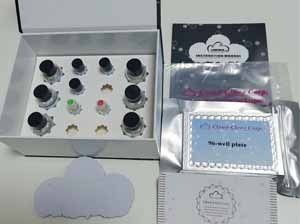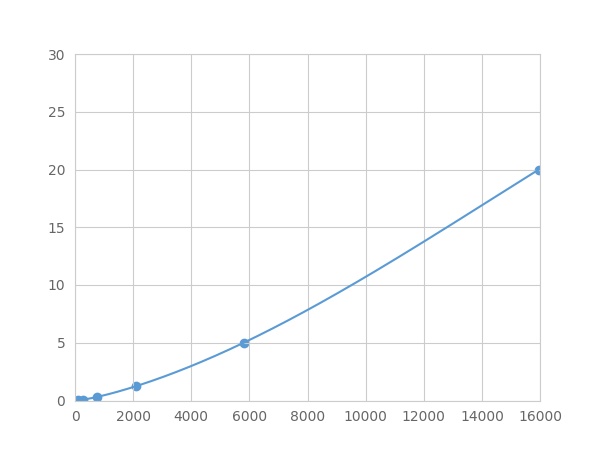Multiplex Assay Kit for Carcinoembryonic Antigen (CEA) ,etc. by FLIA (Flow Luminescence Immunoassay) 

CD66E; CD66; CEACAM5; Carcinoembryonic Antigen-related Cell Adhesion Molecule 5; Carcinoembryonic Antigen
(Note: Up to 8-plex in one testing reaction)
- UOM
- FOB US$ 348.00 US$ 362.00 US$ 382.00 US$ 409.00 US$ 436.00 US$ 476.00 US$ 536.00 US$ 670.00
- Quantity
Overview
Properties
- Product No.LMA150Ra
- Organism SpeciesRattus norvegicus (Rat) Same name, Different species.
- ApplicationsFLIA Kit for Antigen Detection.
Research use only - DownloadInstruction Manual
- CategoryTumor immunityGastroenterology
Sign into your account
Share a new citation as an author
Upload your experimental result
Review

Contact us
Please fill in the blank.
Recovery
Matrices listed below were spiked with certain level of recombinant Carcinoembryonic Antigen (CEA) ,etc. by FLIA (Flow Luminescence Immunoassay) and the recovery rates were calculated by comparing the measured value to the expected amount of Carcinoembryonic Antigen (CEA) ,etc. by FLIA (Flow Luminescence Immunoassay) in samples.
| Matrix | Recovery range (%) | Average(%) |
| serum(n=5) | 92-99 | 96 |
| EDTA plasma(n=5) | 80-104 | 92 |
| heparin plasma(n=5) | 92-105 | 97 |
Precision
Intra-assay Precision (Precision within an assay): 3 samples with low, middle and high level Carcinoembryonic Antigen (CEA) ,etc. by FLIA (Flow Luminescence Immunoassay) were tested 20 times on one plate, respectively.
Inter-assay Precision (Precision between assays): 3 samples with low, middle and high level Carcinoembryonic Antigen (CEA) ,etc. by FLIA (Flow Luminescence Immunoassay) were tested on 3 different plates, 8 replicates in each plate.
CV(%) = SD/meanX100
Intra-Assay: CV<10%
Inter-Assay: CV<12%
Linearity
The linearity of the kit was assayed by testing samples spiked with appropriate concentration of Carcinoembryonic Antigen (CEA) ,etc. by FLIA (Flow Luminescence Immunoassay) and their serial dilutions. The results were demonstrated by the percentage of calculated concentration to the expected.
| Sample | 1:2 | 1:4 | 1:8 | 1:16 |
| serum(n=5) | 88-97% | 81-99% | 83-99% | 96-104% |
| EDTA plasma(n=5) | 95-105% | 80-89% | 80-99% | 96-103% |
| heparin plasma(n=5) | 91-105% | 96-104% | 98-105% | 87-96% |
Stability
The stability of kit is determined by the loss rate of activity. The loss rate of this kit is less than 5% within the expiration date under appropriate storage condition.
To minimize extra influence on the performance, operation procedures and lab conditions, especially room temperature, air humidity, incubator temperature should be strictly controlled. It is also strongly suggested that the whole assay is performed by the same operator from the beginning to the end.
Reagents and materials provided
| Reagents | Quantity | Reagents | Quantity |
| 96-well plate | 1 | Plate sealer for 96 wells | 4 |
| Pre-Mixed Standard | 2 | Standard Diluent | 1×20mL |
| Pre-Mixed Magnetic beads (22#:CEA) | 1 | Analysis buffer | 1×20mL |
| Pre-Mixed Detection Reagent A | 1×120μL | Assay Diluent A | 1×12mL |
| Detection Reagent B (PE-SA) | 1×120μL | Assay Diluent B | 1×12mL |
| Sheath Fluid | 1×10mL | Wash Buffer (30 × concentrate) | 1×20mL |
| Instruction manual | 1 |
Assay procedure summary
1. Preparation of standards, reagents and samples before the experiment;
2. Add 100μL standard or sample to each well,
add 10μL magnetic beads, and incubate 90min at 37°C on shaker;
3. Remove liquid on magnetic frame, add 100μL prepared Detection Reagent A. Incubate 60min at 37°C on shaker;
4. Wash plate on magnetic frame for three times;
5. Add 100μL prepared Detection Reagent B, and incubate 30 min at 37°C on shaker;
6. Wash plate on magnetic frame for three times;
7. Add 100μL sheath solution, swirl for 2 minutes, read on the machine.

Test principle
Analyte-specific antibodies are pre-coated onto color-coded microparticles. Microparticles, standards, and samples are pipetted into wells and the immobilized antibodies bind the analytes of interest. After washing away any unbound substances, a biotinylated antibody cocktail specific to the analytes of interest is added to each well. Following a wash to remove any unbound biotinylated antibody, Streptavidin-Phycoerythrin conjugate (Streptavidin-PE), which binds to the biotinylated detection antibodies, is added to each well. A final wash removes unbound Streptavidin-PE and the microparticles are resuspended in buffer and read using the Luminex or Bio-Plex analyzer.The MFI developed is proportional to the concentration of analytes of interest in the sample.
Giveaways
Increment services
Citations
- Ginger ingredients inhibit the development of diethylnitrosoamine induced premalignant phenotype in rat chemical hepatocarcinogenesis modelPubMed: 20872761
- Comparison of angiotensin converting enzyme inhibitors and angiotensin II type 1 receptor blockade for the prevention of premalignant changes in the liverScienceDirect: S0024320511002700
- Saffron Aqueous Extract Inhibits the Chemically-induced Gastric Cancer Progression in the Wistar Albino RatPubMed: PMC3637902
- Handy, rapid and multiplex detection of tumor markers based on encoded silica-hydrogel hybrid beads array chipPubmed: 23672876
- Association of Paraoxonase-1 (Q192R and L55M) Gene Polymorphisms and Activity with Colorectal Cancer and Effect of Surgical Intervention.Pubmed:25684529
- Detection of HIV-1 p24 antigen using streptavidin–biotin and gold nanoparticles based immunoassay by inductively coupled plasma mass spectrometryRsc:Source
- Activated Leukocyte Cell Adhesion Molecule (ALCAM) in Saudi Breast Cancer Patients as Prognostic and Predictive IndicatorPubMed: 26446295
- Gene expression analysis in the lung of the rasH2 transgenic mouse at week 4 prior to induction of malignant tumor formation by urethane and N-methylolacrylamidePubMed: 26558449
- Collecting Protein Biomarkers in Breath Using Electret Filters: A Preliminary Method on New Technical Model and Human StudyPubmed:26934615
- Chemopreventive effect of Indigofera linnaei extract against diethylnitrosamine induced hepatocarcinogenesis in rats2071_pdf.pdf
- Temporal Sensing Platform Based on Bipolar Electrode for the Ultrasensitive Detection of Cancer Cellspubmed:27506255
- Anticarcinogenic potential of ethanol extract of Indigofera cordifolia Roth.(Fabales: Fabaceae) on diethylnitrosamine induced hepatocarcinogenesis in ratsv04n07a07a
- Ultrasensitive cathode photoelectrochemical immunoassay based on TiO2 photoanode-enhanced 3D Cu2O nanowire array photocathode and signal amplification by …Pubmed:29866267
- Evaluation of Detection Methods and Values of Circulating Vascular Endothelial Growth Factor in Lung CancerPubmed:29675110
- 8-Hydroxy-2'-deoxyguanosine as a Discriminatory Biomarker For Early Detection of Breast Cancer
- Preventive potential of dietary inclusion of Brachystegia eurycoma (Harms) seeds on N-methyl-N-nitrosourea-induced colon carcinogenesis in Wistar ratsPubmed: 30953819
- Chemopreventive effects of on diethylnitrosamine induced and Indigofera cassioides phenobarbital promoted rat liver carcinoma
- DNA-templated porous nanoplatform towards programmed “double-hit” cancer therapy via hyperthermia and immunogenicity activationPubmed: 31374481
- Piperine Regulates Nrf-2/Keap-1 Signalling and Exhibits Anticancer Effect in Experimental Colon Carcinogenesis in Wistar RatsPubmed: 32967203
- Evaluation of the Diagnostic and Predicative Values of 8-Iso-Prostaglandin F2α as a Biomarker of Breast CancerPubmed: 32721979
- Chemopreventive effect of dietary inclusion with Crassocephalum rubens (Juss ex Jacq) leaf on N-methyl-N-nitrosourea (MNU)-induced colorectal carcinogenesis in …
- Lateral Flow Immunosensor for Ferritin Based on Dual Signal-Amplified Strategy by Rhodium Nanoparticles
- Anti-Cancer Activity of Piperine Against Colon Carcinogenesis Via Modulation of NF-κB/Nrf-2/Keap1/HO-1 Signalling Pathways
- Magnetic immunoassay for tumor clinical diagnosis based on rolling circular amplification (RCA) coupled with ICP-MS
- Anticancer efficacy of β-Sitosterol Loaded Hydroxyapatite-Alginate on Colon Cancer Cell in Vivo
- A light-induced self-powered competitive immunosensor for the detection of platelet derived growth factor-BB via an elaborately assembled bioconjugate








